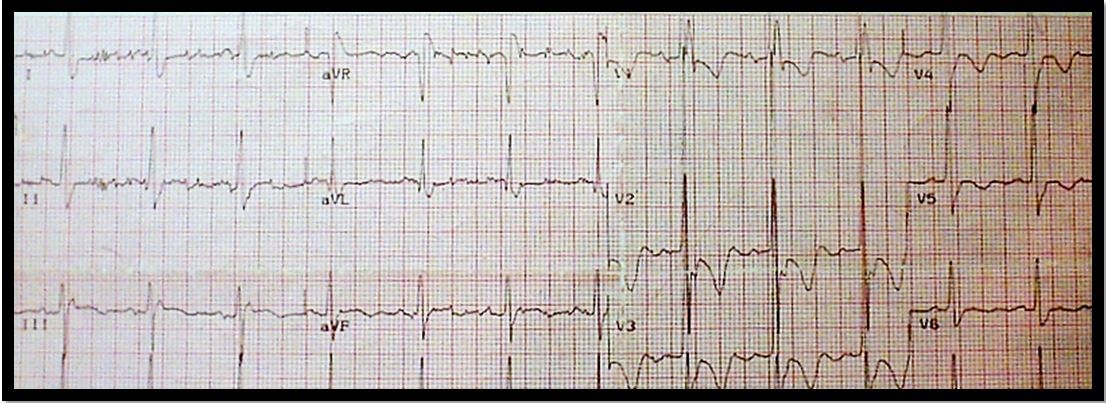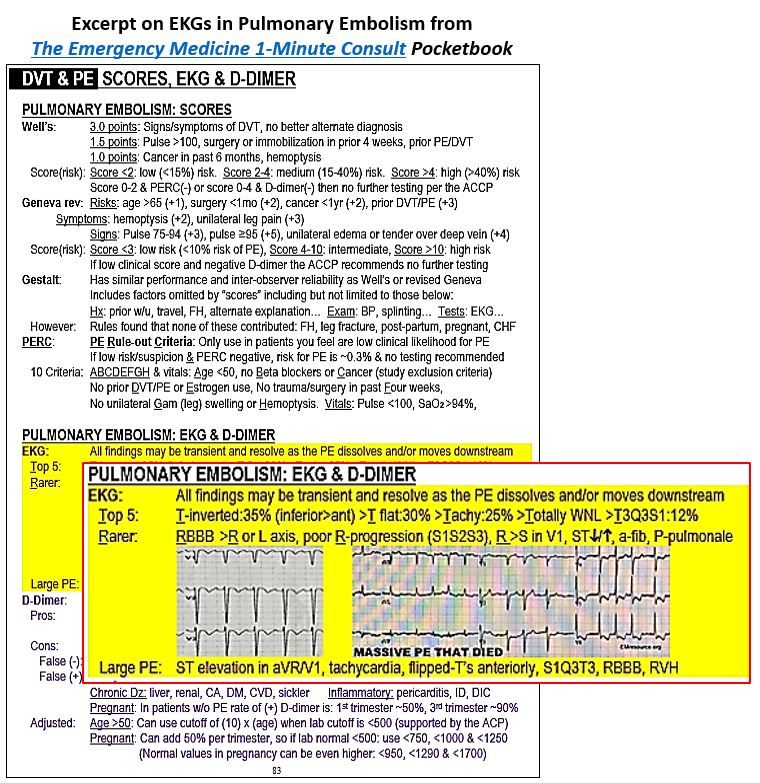ECG Challenge: Elderly, Diaphoretic, and Short of Air
An 82-year-old woman presents with acute worsening of dyspnea, dry cough, and subjective fever and sudden onset of sweating. She denies chest pain. What's your ECG read?
Figure 1. (Please click to enlarge)

Figure 2. (Please click to enlarge)

Patient history
An 82-year-old woman with a history of diabetes on metformin and hypertension on atenolol presents to the emergency department for feeling SOA (short of air). She states that the dyspnea is worse with exertion, and that she also has a dry cough and has felt feverish. All of these symptoms have been present for the past 3 days, but everything got suddenly much worse about 30 minutes ago. She adds that she started sweating at that time as well, which had not happened previously. She denies any chest pain or discomfort, leg swelling, or other complaints.
Vital signs and physical examination
Vital signs are normal except for elevated temperature (99.6°F). Her physical exam is otherwise normal except for xanthelasma and minimal bilateral wheezing. There are no rales, tachycardia, peripheral edema, or other abnormal findings.
Initial differential diagnosis:
- Acute coronary syndrome (ACS)
- Congestive heart failure (CHF)
- Pulmonary emoblism (PE)
- Bronchitis
- Pneumonia
- COPD
Initial diagnostic testing results
- CBC is normal except for a WBC count of 17,000
- Basic metabolic panel is normal
- Troponin is elevated at 0.14 ng/L and BNP is elevated at 340 ng/L
- Chest x-ray shows atelectasis and a slightly elevated right hemidiaphragm
- ECG tracing is shown in Figure 1 above (please click on image to enlarge)
Questions
1. What does the EKG show?
2. What should you do next?
Please click here for answers and discussion.
Answers
1. What does the ECG tracing show? The image shows anterior T-wave inversion, among other findings. Anterior T-wave inversion can certainly be from ACS, but it is also common in the presence of a large or submassive PE. Although rarely publicized, sweating and absence of chest pain are not at all uncommon in patients with large PEs, nor are mild elevations of the troponin, BNP, and even the WBC count.
2. What should you do next? Start heparin for possible ACS and possible PE. Consider antibiotics for possible pneumonia and get a VQ (ventilation-perfusion) or CT scan of the chest to evaluate for PE. Before any of this, though, repeat the ECG. Since her symptoms worsened only about 30 minutes ago, you want to make certain she is not experiencing an evolving STEMI.
Discussion
The classic ECG findings seen in patients with PE that most health care providers are well aware of actually are somewhat uncommon and typically only occur in larger PEs. Smaller emboli do not cause much in the way of ECG changes at all; the test is often completely normal.
The top 5 most common ECG findings in PE are listed in the highlighted area of the page shot in Figure 2 above, with the mnemonic “T.” The most common finding is anterior T-wave inversion, followed closely by flat T-waves, Tachycardia and Totally normal ECG. Findings considered rare are listed below that with the mnemonic “R.” Finally, ECG findings in massive and submassive PE, the ones most likely to also cause elevations of troponin, BNP and WBC count, are listed and include tachycardia, ST elevation, especially in the right-sided leads, anterior flipped T-waves, S1Q3T3, right bundle branch block, and right ventricular hypertrophy.
There are a lot of myths propagated in medical school and residency about PE. Some of the important truths to be aware of are:
- Tachycardia is actually uncommon in smaller Pes
- Lack of pain is not uncommon in a large PE
- Elevations in troponin, BNP and WBC count are fairly common in large PEs
Case conclusion
The patient had multiple submassive PEs. She also had a large nonocclusive DVT in her right leg. She decompensated despite heparin and was started on half dose TPA.